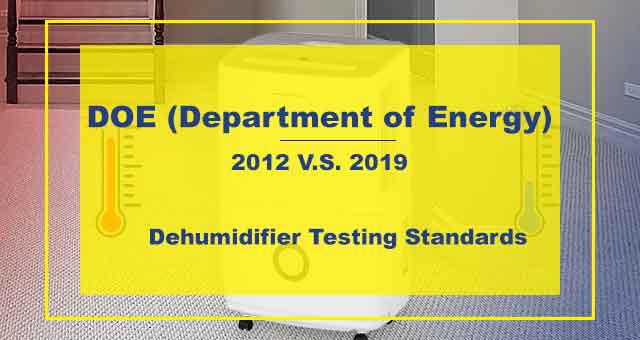Before a dehumidifier unit is released and sold by a manufacturer, it must pass certain standard testing by U.S. Department of Energy (DOE).
These standard tests determine dehumidifier effectiveness with respect to moisture removal and power consumption under ambient room temperature.
Below are some frequently asked questions regarding a dehumidifier’s DOE testing standards.
Table Of Content
- What Changed between 2012 and 2019 in DOE testing standards?
- Major Reason Behind these Changes?
- Do the Changes Affect Dehumidifiers’ Performance?
- Do You Need to Replace Your Old Unit with a New One?
- What Brands are Using the New Ratings?
- How Do I Find the Right Dehumidifier for My Space with the New Rating?
- Do I have to Buy a New Dehumidifier with the Same Extraction Rating as the Older One?
- Do the New Test Standards Affect the Price?
Dehumidifier Performance and Testing: What Changed between 2012 and Jun 2019?
Dehumidifier capacity ratings pint/day means how much moisture a dehumidifier can remove. Which means higher the capacity of a dehumidifier its recommended for more wetter and larger areas.
Back in 2012, DOE determined the effectiveness and efficiency of a dehumidifier by testing it under ambient conditions of 80 degrees Fahrenheit and 60% humidity. Consequently, the manufacturers built dehumidifiers with a moisture removal capacity ranging between 30 and 70 pints within 24 hours.
In 2019, however, DOE changed its approach and made the testing environment for testing each unit under room conditions of 65°F and 60% humidity. As such, you will find newer dehumidifiers having a moisture removal capacity ranging from 20 to 50 pints per 24 hours.
| Testing Environment | DOE 2012 Standards (OLD) | DOE 2019 Standards (CURRENT) |
|---|---|---|
| Room Ambient Temperature (°F) | 80 | 65 |
| Relative Humidity | 60% | 60% |
What’s the Reason Behind these Changes?
The primary reason for the current changes is to provide more accurate information to consumers.
DOE changed these settings to suit the average ambient conditions of underground rooms, given that most homeowners use these devices in their basements.
There is less moisture to remove from spaces with colder temperatures, and hence the newer models come with lower capacity but are as effective as their predecessors.
Do the Changes Affect Dehumidifiers’ Performance?
The simple answer is no.
Dehumidifiers still have the same components as they did in the past. They will also work with the same efficiency as their older counterparts.
Do I Need to Replace My Old Unit with a New One?
You don’t have to.
The main difference between the older and new dehumidifier models is DOE’s testing conditions. However, you may replace your unit if you need to create a specific ambiance in your room, as the new models will provide you with better accuracy than the older devices.
What Brands are Using the New Ratings?
Any dehumidifier produced after 2019 is likely to come with the new ratings, regardless of the brand or model. This is because it has to pass DOE standards before reaching the market.
How Do I Find the Right Dehumidifier for My Space with the New Rating?
The area of coverage for dehumidifiers is not in any way affected by the new test standards.
You, however, need to compare your prospective dehumidifier’s rating to the temperature and RH levels in the spaces from which you’re looking to extract moisture.
RELATED: We have put together detailed review of some of the highly recommended dehumidifiers.
Do I have to Buy a New Dehumidifier with the Same Extraction Rating as the Older One?
Again, simple answer is no.
There is a 15% temperature difference in testing standard. This change only lowered the Pint Capacity what was known prior to 2019 is now less as of June of 2019.
However, each dehumidifier still removes the same amount of water as it did prior to the changes. Therefore, if you owned a 50 Pint Dehumidifier prior to 2019 then equivalent dehumidifier would be 30 Pint.
Below we have put together a table for your better understanding.
| Portable Dehumidifier | Whole-house Dehumidifier | ||
|---|---|---|---|
| Old Capacity (Pint/Day) | New Capacity (Pint/Day) | Old Capacity (Pint/Day) | New Capacity (Pint/Day) |
| 30 | 20 | 80 | 70 |
| 40 | 25 | 100 | 85 |
| 50 | 30 | 120 | 100 |
| 55 | 30-35 | 140 | 115 |
| 60 | 35 | 160 | 135 |
| 70 | 40-45 | 200 | 170 |
| 90 | 55 | ||
Do the New Test Standards Affect the Price?
The cost of dehumidifiers are not affected by the new ratings. This is because the recent changes are irrelevant to the performance of the new dehumidifiers.
The Bottom Line
To summarize, DOE is tasked with testing dehumidifiers to determine their performance. This department focuses on two primary parameters, which include moisture extraction capacity per day and energy efficiency. Their primary task is accomplished by determining the amount of moisture a unit can extract in kilowatts within an hour.
They recently changed their standards from 80 degrees Fahrenheit to 65°F, which reduces the dehumidifier’s extraction rating. The newer models are now tested to suit your home’s environment, including your basement settings.

